3. Innovation activity related to products and processes
Of the surveyed enterprises, 58 per cent reported having developed or introduced product or process innovations in 2014 to 2016. This is ten percentage points more than in the previous survey.
3.1 Every tenth turnover euro from innovative products
Of the enterprises, 43 per cent reported that they had implemented product innovations to the markets in 2014 to 2016. In manufacturing, the share was 45 per cent and in services, 41 per cent. In manufacturing, introduction of product innovations naturally focuses on goods but as the share of those having launched services has also grown considerably, the share of enterprises that have launched services was now good one-fifth of enterprises, while it has been 14 per cent in previous surveys. In services, the shares of both those having introduced new goods and new services to the markets have similarly grown.
The share of enterprises in the smallest size category having introduced product innovations to the markets was 39 per cent, and in the biggest size category it was 69 per cent. In relative terms, introduction of innovative services to the markets has increased most in small and medium-sized enterprises in recent years.
In manufacturing, the share of those having introduced product innovations to the market was biggest, 78 per cent of the enterprises in the industry, in the manufacture of computer, electronic and optical products. The majority of these enterprises reported product innovations but 45 per cent of enterprises in the industry had introduced service innovations.
As in the previous years, the share of those having introduced product innovations to the markets was biggest in services in computer programming, where 76 per cent reported product innovations. Most of them reported service innovations, but product innovations are also common in the field, as one-half of those having innovated reported them.
Figure 6. Introduction of product innovations in manufacturing by industry in 2014 to 2016, share of enterprises
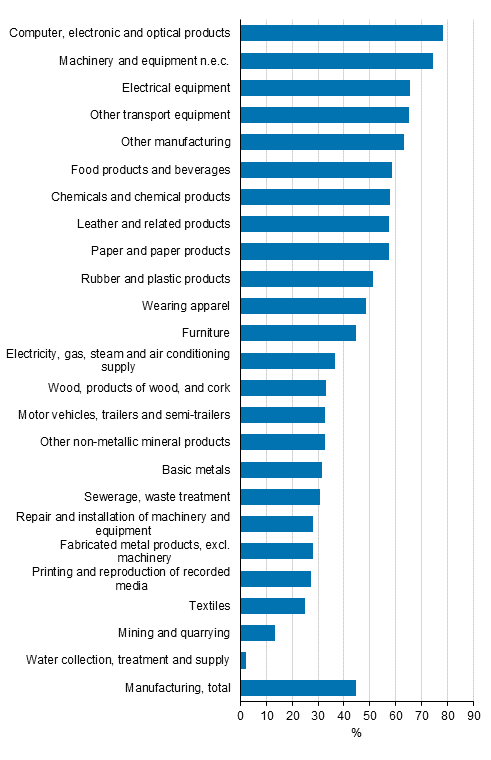
Figure 7. Introduction of product innovations in services by industry in 2014 to 2016, share of enterprises

The image of the developer that has originally developed the product innovations introduced to the markets has remained fairly similar from one year to the next. The majority of those having introduced product innovations to the markets have developed innovations by themselves. Good one-half reported having developed innovations together with other enterprises or organisations, and around one in three has produced such product innovations that were remodelled products originally developed by others.
An overview of how large share of those having introduced product innovations to the markets has launched products with different novelty values has remained very similar in recent years. To be an innovation the product must be new or significantly differing from before at least to the enterprise producing it. The Innovation Survey classifies product innovations by type into two groups according to whether innovations were new only to the enterprises that produced them – that is, corresponding ones have already been on the market – or whether innovations were new also to the market – that is, corresponding products have not been previously available.
Nearly two-third of those having reported product innovations in 2014 to 2016 said they launched both products that were new to the enterprise's production, but not to the markets, and products that were also new to the enterprise's markets. Good 40 per cent introduced only product innovations that were new from the viewpoint of own production to the market, and around one in four enterprises said their product innovations were new for its markets.
Twenty-nine per cent of the smallest size enterprises having introduced product innovations to the markets reported launching of both new products to the markets and products only new to the enterprise. For large enterprises, the share was correspondingly 54 per cent.
Figure 8. Distribution of product innovations by novelty value and size category of personnel in 2014 to 2016, share of those with introductions of product innovations to the markets
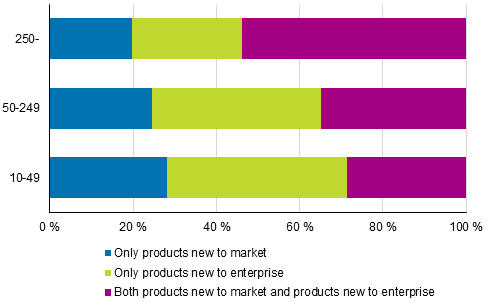
In 2016, around 10 per cent of the turnover of those having introduced product innovations to the market came from new products to the markets, the share being 11 per cent in manufacturing and eight per cent in services. The share of turnover for those innovations that were new only to the enterprises having produced them was seven per cent, in manufacturing enterprises 10 per cent and in services four per cent.
Figure 9. Share of turnover derived from product innovations in manufacturing and services in 2006 to 2016, share of turnover of enterprises having introduced product innovations to the markets
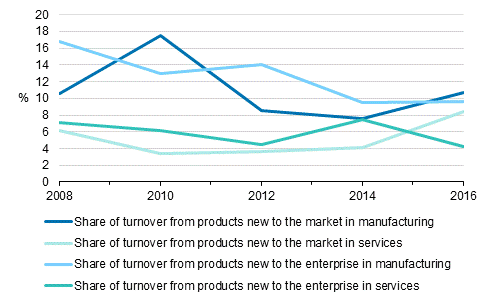
The turnover derived from new products to the market represented good six per cent of the combined turnover of all enterprises in the survey. The turnover from products new only to the enterprises, in turn, formed five per cent of the combined turnover of all enterprises. In all, around 11 per cent of the turnover of the examined industries in 2016 came from product innovations launched on the market during 2014 to 2016. This is on the same level as in the previous surveys.
3.2 Nearly every second manufacturing enterprise renewed its processes
Altogether, 41 per cent of the surveyed enterprises implemented process innovations in 2014 to 2016. As in other innovation activity, this was clearly more than in previous surveys, when nearly one-third of enterprises reported process innovations.
In manufacturing, the share of enterprises having implemented process innovations was 47 per cent and in services 36 per cent. Of manufacturing industries, process innovations were reported most often by the manufacture of paper and paper products, the manufacture of other non-metallic mineral products and the manufacture of electrical equipment. For example, in the paper industry, process innovations were reported by 69 per cent of enterprises. In services, the implementation of process innovations was most common in computer programming, where 58 per cent reported innovations.
In the survey, process innovations are divided into innovations related to production methods, distribution methods and supporting activities. Enterprises most commonly reported innovations related to supporting activities serving enterprises’ processes.
Figure 10. Prevalence of process innovations in manufacturing and services in 2006 to 2016, share of enterprises
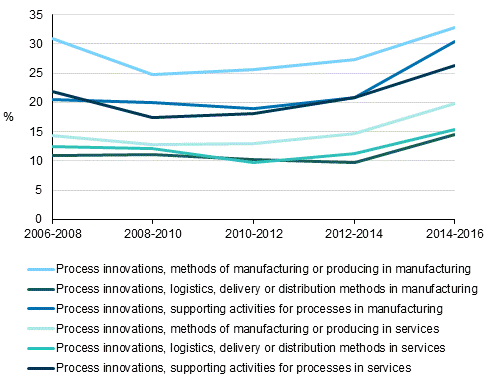
While three-quarters of those having introduced product innovations in the markets developed product innovations by themselves, for process innovations the share was 56 per cent. In all, 58 per cent of those having adopted innovative processes reported having developed innovations together with other enterprises or organisations, and one quarter said they had adapted or remodelled process innovations originally developed by others.
3.3 Every third had projects related to development and implementation of product and process innovations
Innovation activity related to products and processes also includes projects and activities that do not, for one reason or another, result in completion and implementation of innovations during the reference period – either due to suspension of the activity or the activity still continuing. In all, 35 per cent of enterprises reported such projects or activities. In all, 12 per cent of enterprises reported projects suspended before completion and one-third of enterprises had projects and activities aiming at innovations that still continued after the end of the survey period at the end of 2016.
3.4 Change in the structure of innovation expenditure
The generality of various actions related to innovation activity was as a whole similar to previous years in 2014 to 2016. Three in four enterprises with innovation activity related to products and processes were engaged in their own research and development (R&D). Around one-third of enterprises with innovation activity had regular R&D, meaning that the enterprise had its own permanent R&D personnel, and 41 per cent of enterprises reported occasional R&D. All in all, 51 per cent those with innovation activity had commissioned research and development activity from outside the enterprise.
Two out of three had made equipment and machine acquisitions related to innovation activity, and 40 per cent had acquired existing competence and knowledge, work protected by copyrights or patented and non-patented inventions or the like from enterprises or organisations for developing new or essentially improved products and processes. Forty per cent of enterprises with innovation activity reported training related to innovation activity, 43 per cent activities related to market introduction of innovations and 27 per cent design related to product innovations.
Apart from R&D and machine and equipment acquisitions related to innovation activity, various activities appear more or less as generally in the innovation activity of manufacturing and service industries.
Figure 11. Prevalence of various types of innovation activity in manufacturing and services in 2014 to 2016, share of enterprises with innovation activity related to products and processes
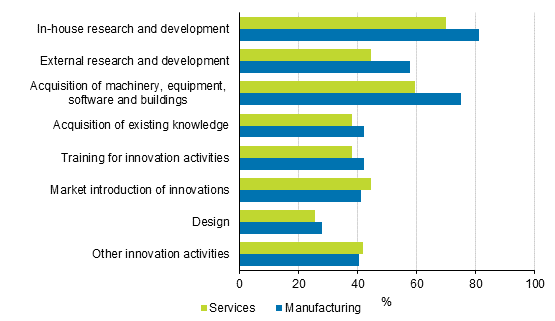
The characteristics of innovation activity and prevalence of various types of innovation activity thus appeared similar to before among those having had innovation activity. When examining innovation activity relative to the entire targeted enterprise group, we can see that activities have become more general particularly for R&D and acquisitions of innovative machines, equipment and the like. For other activities, they have become more common moderately positively.
Figure 12. Prevalence of various types of innovation activity in 2006 to 2016, share of enterprises
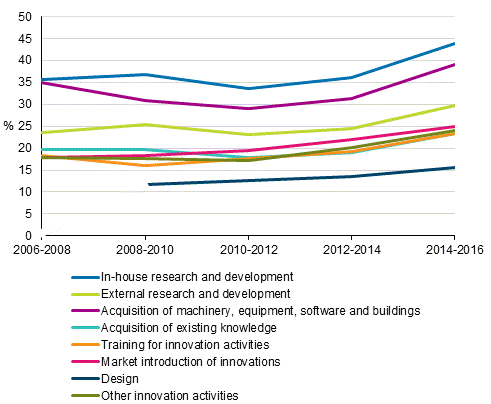
The expenditure of innovation activity reported by enterprises in 2016 remained on the whole on level with the previous survey, that is, of 2014, when they were close on EUR six billion. In 2016, expenditure totalled a bit over EUR six billion, EUR 4.3 billion in manufacturing and EUR 1.7 billion in services.
A significant structural change took place in the innovation expenditure of manufacturing, because the expenditure of research and development still fell considerably from previous surveys and, on the other hand, machine, equipment, software and building investments on innovation activity related to other than R&D grew considerably. The latter was closely influenced by investments of the forest industry and related innovative acquisitions.
In services, the decrease in R&D expenditure was compensated by growth in other innovation expenditure, particularly as concerns market introduction of products. In this respect, a significant addition was recorded in the banking and insurance sector.
Figure 13. Distribution of innovation expenditure in 2008 to 2016, EUR million
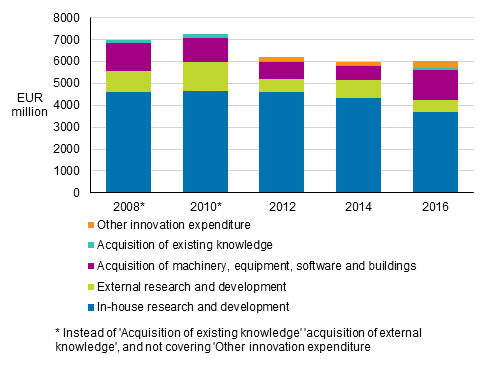
Figure 14. Distribution of innovation expenditure in manufacturing and services in 2012 to 2016, EUR million
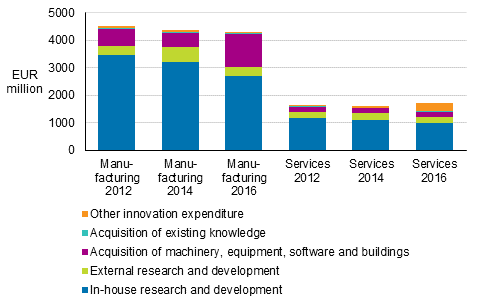
3.5 Public financial support to innovation activity
In all, one-third of those having developed and implemented product and process innovations in 2014 to 2016 received public financial support for their innovation activity. In relative terms, support was received most commonly by the biggest enterprises in the target population, of which 49 per cent reported support. Thirty-four per cent of medium-sized enterprises received support and 32 per cent of enterprises employing 10 to 49 persons. Compared to the previous survey, the number of enterprises having received support to innovation activity grew clearly among the group of the smallest enterprises.
The shares of those having received support among those with innovation activity were in practice on level with the previous survey; 28 per cent received support from the State, nine per cent from local or regional authorities and six per cent from the European Union. Nearly three per cent of those with innovation activity took part in the EU 7th Framework Programme for Research and Technical Development or in the Horizon 2020 Programme for Research and Innovation.
3.6 Own enterprise and group and suppliers of equipment and materials still the most important information sources for innovation
One's own enterprise and group and suppliers of equipment and materials are still the most important information sources for enterprises’ innovation activity. Enterprises feel the next most important are private sector customers, competitors or other enterprises in their industry, and conferences, fairs and exhibitions. For instance, around seven out of ten enterprises with innovation activity assessed competitors and other enterprises in the industry as significant information sources for developing innovations.
The least used information sources – as well as the least important one – are private and public research institutes.
Figure 15. Information sources of innovation activity by importance in 2014 to 2016, share of those with innovation activity related to products and processes
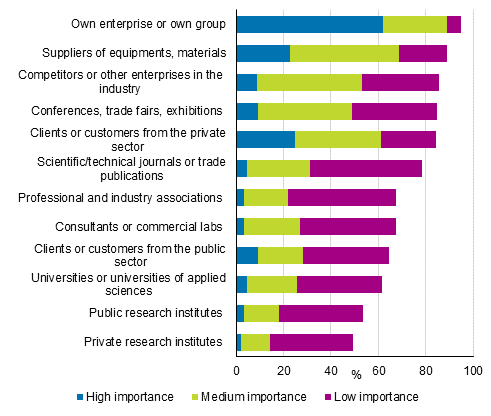
Information sources of innovation activity were last inquired for the years 2010 to 2012. The most recent data are on the general level very similar to those reported at that time. The importance of equipment suppliers as information sources has risen somewhat, because in the previous survey, it was recorded as having high or medium importance by 61 per cent of those having innovated products or processes, and now the corresponding share was 69 per cent.
3.7 Every fifth enterprise cooperates in innovation projects
Thirty-nine per cent of those with product and process innovations had innovation cooperation, or active participation in innovation projects with other enterprises and organisations. This was 23 per cent of all enterprises in the survey.
The share of enterprises with innovation activity that cooperated has been relatively stable in recent years, slightly under 40 per cent. In the previous survey, the share was 38 per cent, and in the preceding one, 36 per cent.
In 2014 to 2016, innovation cooperation was most commonly reported with suppliers of equipment, private sector customers and universities and universities of applied sciences. Seventeen per cent of those with innovation activity had cooperated with enterprises in their own group, 29 per cent with suppliers of equipment, around one quarter with private sector customers and similarly, around one-quarter of those having innovated products and processes with universities. Cooperation was reported still more often in manufacturing than in services.
Figure 16. Cooperation related to innovation activity with different cooperation partners in manufacturing and services in 2014 to 2016, share of enterprises with innovation activity related to products and processes

In all, 95 per cent of those with innovation activity reported cooperation with domestic cooperation partners. Six out of ten of those having cooperated had collaborated with cooperation partners in other European countries, the share being 66 per cent in manufacturing and 52 per cent in services. Every fifth of those having reported innovation cooperation had had cooperation partners in the United States. Although the shares of those having reported innovation cooperation in Europe and the United States had fallen among those with innovation activity compared with earlier surveys, the share of those having cooperated did not, however, change that significantly because considerably more innovation activity was reported now than before.
Source: Innovation 2016, Statistics Finland
Inquiries: Mervi Niemi 029 551 3263, Heidi Pirkola 029 551 3246, tiede.teknologia@stat.fi
Director in charge: Sami Saarikivi
Updated 12.4.2018
Official Statistics of Finland (OSF):
Innovation [e-publication].
ISSN=1797-4399. 2016,
3. Innovation activity related to products and processes
. Helsinki: Statistics Finland [referred: 24.12.2025].
Access method: http://stat.fi/til/inn/2016/inn_2016_2018-04-12_kat_003_en.html

